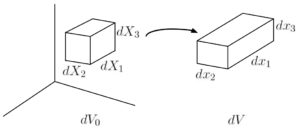For completeness, we’ll derive the volume change and area change:

(1) ![]()
Derivation starts from the triple scalar product. Cross products and determinants (written in tensor form) is a math topic, so we’ll skip the derivation of volumetric deformation. A quick derivation of volumetric deformation without the use of indices can be found in [Bonet].
note:
Nanson’s Equation:
Now we know that ![]() , but what about area?
, but what about area?
If ![]() is the initial area and
is the initial area and ![]() is the final area:
is the final area:
For small volumes, we can say that ![]() and
and ![]() .
.
It was previously shown that ![]()
![]()
![]() and
and ![]()
![]()
Substituting, we get ![]()
We also know that ![]()
(2) ![]()
where ![]() and
and ![]() are the normal vectors to the surface in the respective initial and final configurations.
are the normal vectors to the surface in the respective initial and final configurations.
Eq. 2 is called Nanson’s Equation and will be useful later when we look at “true” stress versus “nominal” stress, for example.
- J. Bonet and R. Wood, Nonlinear Continuum Mechanics for Finite Element Analysis. 1997, Cambridge University Press, Cambridge.
[Bibtex]@book{Bonet, title={Nonlinear {C}ontinuum {M}echanics for {F}inite {E}lement {A}nalysis. 1997}, author={Bonet, J and Wood, RD}, publisher={Cambridge University Press, Cambridge} }
